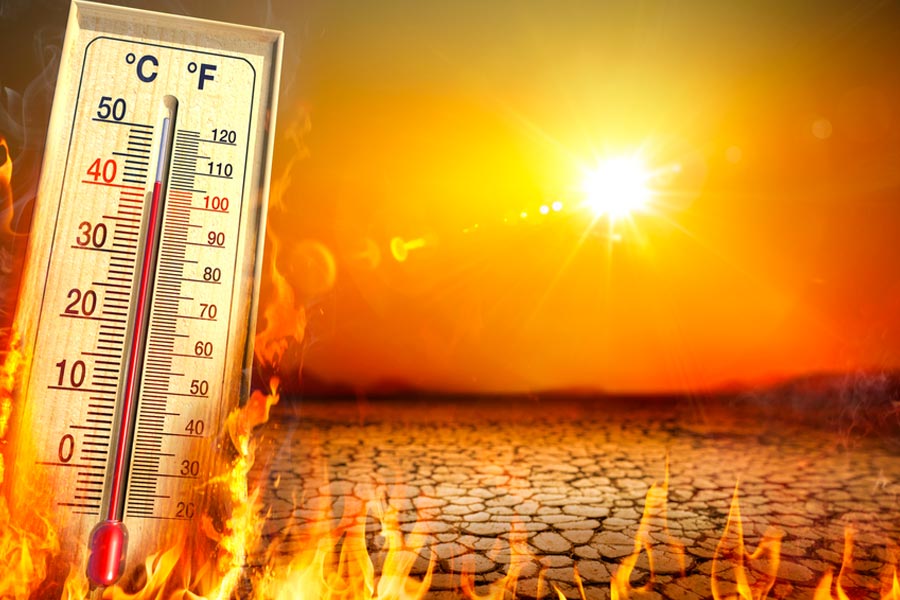
Jalpaiguri bears brunt of climate at night: Rise in temperature imperils sound sleep in several Indian towns
The analysis, which considered 24 global climate assessment models, observed that out of the 870 nights, 868 had the minimum temperature aove 25 degrees Celsius because of climatic impacts
Jayanta Basu, TT, Calcutta, 24.06.24 : Jalpaiguri, the north Bengal town, had the greatest number of climate change-triggered hot nights in India during the last decade, finds a global report released on Friday.
The report considered around 300 Indian cities with over one lakh population.
The analysis, prepared by environmental outfit Climate Central and Climate Trends, has found that Jalpaiguri had 870 nights during 2014-2023, when the minimum temperature, considered equivalent to night time temperature, exceeded 25 degrees Celsius, a benchmark for an unusually heated night as sleep gets disturbed above that limit.
The analysis, which considered 24 global climate assessment models, observed that out of the 870 nights, 868 had the minimum temperature aove 25 degrees Celsius because of climatic impacts.
Siliguri, with 810 nights crossing 25 degrees Celsius, which is attributable to climate change, is fifth in the country while Guwahati, Silchar and Dibrugarh in Assam occupied the second, third and the fourth positions in the country, respectively.
“Climate change has had a major influence on nighttime temperatures above 25 degree Celsius in India … West Bengal and Assam are the regions that have been most impacted, with cities like Jalpaiguri, Guwahati, Silchar, Dibrugarh and Siliguri experiencing between 80 and 86 additional days each year above the 25 degree Celsius C threshold due to climate change, on average,” reads the report.
K.J. Ramesh, former director general of the India Meteorological Department, told The Telegraph on Saturday: “The trend, which you mention, is 100 per cent correct. The cities in the hilly part, mainly in eastern and northeast states, are most affected by climate change as expressed through heightened night time temperatures.”
“The urban heat island effect is most visible in the night-time temperatures. The high-rise buildings and concrete set-up in the cities do not let the excess heat escape during the night,” pointed out Roxy Mathew Koll, a climate scientist with Indian Institute of Tropical Meteorology, Pune.
Recent research on north Bengal’s urban areas, including Jalpaiguri, vindicates the findings, which traditionally have a lot of open and green spread.
“Urbanization in North Bengal has accelerated in recent decades … the level of urbanization in North Bengal was 13.52 percent in 1991, 14.16 percent in 2001, and 18.70 percent in 2011,” reads a 2023 research paper by Sukomal Chanda in the department of history in Cooch Behar Panchanan Barma University.
Jalpaiguri residents corroborated that there had been a rise in night temperature in the past decade.
“There was a major change in climatic conditions in Jalpaiguri over the past few years. These days, air-conditioners are there in residential and commercial places and we have to use them to beat the heat even during night hours,” said Chumki Bhattacharya, a schoolteacher.
She said multi-storied buildings had replaced old wooden structures. “You will hardly find a few wooden houses in tottering condition in the town,” she added.
Sources at the IMD office in Calcutta pointed out that the rise in the minimum temperature in Jalpaiguri was in tune with the trend since the early 20th century.
“The finding is consistent with our ground level experience. We are suffering becasue of the combination of heat and humidity and having a high real feel of heat,” said Animesh Bose, a Siliguri-based environmentalist.
The report also shows that the nights have been warming up in Darjeeling, adjoining towns in Sikkim, Balurghat, Raiganj and Englishbazar in north Bengal, and Purulia, Asansol, Bankura and Durgapur in southern parts of the state.
Raja Rauth, a nature conservationist based in Jalpaiguri, said another reason for the rise in temperature was that hundreds of old trees had been chopped off for the four-lane highway which skirts Jalpaiguri and Siliguri.
“The old trees, which used to provide a canopy on the highway, were not replanted. Some planting was carried out on the highway but that’s too little. The green cover is depleting fast becasue of urbanisation,” said Rauth.
Anjal Prakash, a professor in Indian School of Business, observed that “as global warming adds an additional 50 to 80 warm nights or more annually in states like West Bengal, Assam, Kerala and others, the impact on the poor and vulnerable population, without access to proper cooling mechanisms, is profound”.
The surge in night temperature is affecting sleep and impacting health, said doctors.
“When the ambient or room temperature is warmer than usual, it’s more difficult for the body to decrease its temperature for sleep onset. That’s why it is difficult to fall and stay asleep in warmer temperatures. The disruption is also leading to health consequences,” said Arup Haldar, a physician and a sleep expert.
Courtesy & source- The Telegraph

0 Response to " Jalpaiguri bears brunt of climate at night: Rise in temperature imperils sound sleep in several Indian towns"
Post a Comment
Disclaimer Note:
The views expressed in the articles published here are solely those of the author and do not necessarily reflect the official policy, position, or perspective of Kalimpong News or KalimNews. Kalimpong News and KalimNews disclaim all liability for the published or posted articles, news, and information and assume no responsibility for the accuracy or validity of the content.
Kalimpong News is a non-profit online news platform managed by KalimNews and operated under the Kalimpong Press Club.
Comment Policy:
We encourage respectful and constructive discussions. Please ensure decency while commenting and register with your email ID to participate.
Note: only a member of this blog may post a comment.